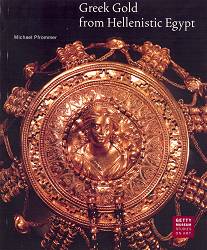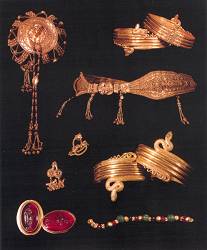ALL THAT GLITTERS MUST BE GREEK
GREEK GOLD FROM HELLENISTIC EGYPT by Michael Pfrommer is a slim but handsome monograph published by the J. Paul Getty Museum as part of its Studies of Art series. The author, a specialist in Hellenistic metalwork, is associate professor of classical archaeology at the University of Trier in Germany and the author of a previous work, Metalwork from the Hellenized East.

Pfrommer was invited to the Getty when the museum acquired a spectacular collection of Hellenistic gold jewelry from the private collectors Lawrence and Barbara Fleischman. The pieces included a magnificent hairnet mounted on a cushion of rose-colored satin, two bracelets of intertwined snakes followed by a large, heavy pair of amulets, each formed by a single coiled serpent, a diadem and two large finger rings, one decorated with an image of Artemis, the other with an image of Tyche. Beads of gold and semiprecious stones and several gold cowrie shells completed the rare assemblage.
These treasures were exhibited to the public for the first time during the symposium on Alexandria and Alexandrianism held at the Getty in 1993. It was on that occasion that Pfrommer first saw the collection. "His interest in the exquisite workmanship and his appreciation for the unusual imagery were so immediately apparent that we invited him to take on the initial publication of this collection," said the museum's Curator of Antiquities.
Pfrommer, joined by Jack Ogden, an English expert on ancient jewelry,
established that all the pieces in the collection were of Hellenistic Egyptian workmanship, circa 350 B.C. Pfrommer not only proves this in GREEK GOLD FROM HELLENISTIC EGYPT, but takes the reader on a journey
through three centuries ranging from the empire-building Alexander to
the beguilingly ambitious Cleopatra VII.
A collection of "such importance raises many questions, particularly what is it and where did it come from," writes Pfrommer. "Was it formerly part of the splendor of a temple, where it perhaps decorated the statue of a goddess? Were the golden hairnet and the shining stephane ornaments for the hair of a priestess? Were the images of deities symbols of piety, or were they symbols of wealth? Were the delicate hoop earrings and the coiled snake amulets and bracelets affectionate gifts to a mother or sister, or were they intended to adorn her on her last journey-- to the funeral pyre--or to comfort her with earthly riches in the tomb?
"Could the jewelry have been worn at royal festivities to glorify the monarchy? Or could these pieces have been symbolic of the increasing wealth of a city on the rise? Is the treasure perhaps the last vestige of a tragedy? Was the jewelry worn by a victim of war or plunder or death? Did the onetime owner hide the gold so well that its whereabouts remained unknown after her demise? Is it a modern assemblage or an ancient treasure? Was it chance that restored the golden treasure to modern wonder--and to all the questions and close examination?"
Pfrommer answers these and other related questions in his smoothly
written, erudite and copiously illustrated book (34 color & 41 b&w plates). In a mere 64 pages of text, he not only delivers a lesson in history and art, but plays the detective. In all, it's a remarkable performance on his part, one that will captivate even those with just a passing interest in antique jewelry.
Published by Getty Publications, 1200 Getty Center Drive, #500, L.A.,
CA. 90049-1682. Ppbk. $17.50; call (310) 440-6795 or visit www.getty.edu
